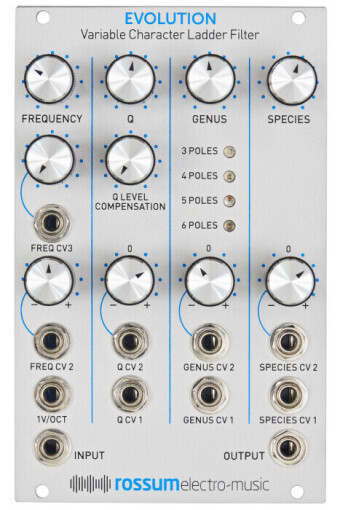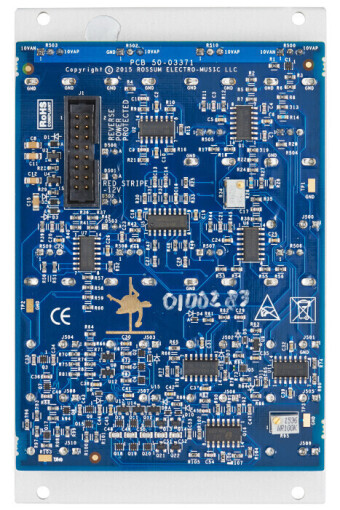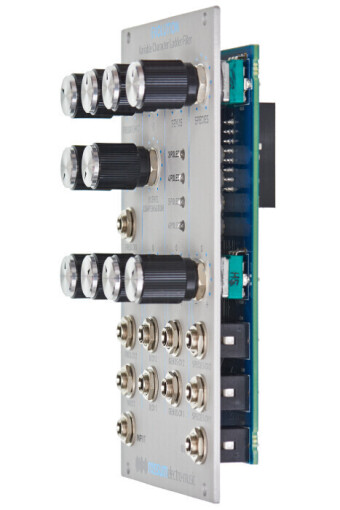Rossum Evolution



 49 810 р. предложить свою цену
45541
49 810 р. предложить свою цену
45541
Купить сейчас
Добавить в корзину
Уведомить о снижении цены
Уведомить о поступлении товара
1973 - Dave Rossum tackles the core of Moog's cascade filter, revises the rest and uses it as a base for the 2100 low pass filter from the E-Mu modular system.
2015 - the evolution of the 2100, Dave's favorite filter, takes place and the result is just this Eurorack module, the EVOLUTION filter.
Almost entirely voltage controlable low pass filter with resonance, Q compensation, self oscillation with outstanding tracking, then very nice and controllable distortion - and on top of that: continuously morphable slope, from -18 to -36 decibel per octave. In case we kept shtum about the sound so far: it is just fantastic!
The aforementioned possibilities already let you have a premonition that the filter is not restricted to one tonal character but rather offers a depth of tone colours, beyond the classic Moog sound. After all as early as 1973 not the whole filter was cloned but an enitrely new one has been designed using the principle of Moog's cascade, having been modernized and highly improved in form of the Evolution module.
Now, about the functions:
As usual the CUTOFF frequency comes with a manual control and a number of CV inputs: FREQ CV3 with an attenauator, FREQ CV 2 with a polarizer and finally a 1V/octave input.
Frequency range is 22Hz to 22kHz (manual) or .02Hz to 40kHz (voltage controlled).
Besides one potentiometer and two CV inputs the filter quality Q (or resonance) parameter offers a purely manual parameter, Q LEVEL COMPENSATIOIN which counterbalances the level loss at high Q settings, something which can be annoying if you prefer having full level in the low-end as well, instead of emphasizing certain harmonics aroundthe resonance frequency.
As temperature stabilization is provided in the the Evolution it can track better than many a VCO! When self oscillating the module is perfectly usable as a high-quality sinewave oscillator for FM applications (works best at -24dB slope [4 pole mode] and when the filter is just barely into oscillation).
Evolution is not limited to one filter slope. Having a number of filter poles it offers four slopes: -18, -24, -30 and -36dB per octave. The GENUS parameter makes it possible to blend smoothly and continously between the slopes, even with CVs, een in audio rate! This feature is unique with Moog cascades!
As the resonance frequencies of the single filter poles differ by some semitones you are able to create arppeggio-like melody patterns when the filter is oscillating by changing the number of filter poles.
SPECIES finally determines the signal level which is sent into the module's distortion circuit. Hovever the latter processes the filter signal only, not the resonance i.e. the dstortion effect is less obvious at high resonance settings. When oscillating this parameter will control the level, though.
Ah, just experiment with all the single parameters and their interactions and have much fun!
Заводская спецификация и комплектация с сайта производителя
2015 - the evolution of the 2100, Dave's favorite filter, takes place and the result is just this Eurorack module, the EVOLUTION filter.
Almost entirely voltage controlable low pass filter with resonance, Q compensation, self oscillation with outstanding tracking, then very nice and controllable distortion - and on top of that: continuously morphable slope, from -18 to -36 decibel per octave. In case we kept shtum about the sound so far: it is just fantastic!
The aforementioned possibilities already let you have a premonition that the filter is not restricted to one tonal character but rather offers a depth of tone colours, beyond the classic Moog sound. After all as early as 1973 not the whole filter was cloned but an enitrely new one has been designed using the principle of Moog's cascade, having been modernized and highly improved in form of the Evolution module.
Now, about the functions:
As usual the CUTOFF frequency comes with a manual control and a number of CV inputs: FREQ CV3 with an attenauator, FREQ CV 2 with a polarizer and finally a 1V/octave input.
Frequency range is 22Hz to 22kHz (manual) or .02Hz to 40kHz (voltage controlled).
Besides one potentiometer and two CV inputs the filter quality Q (or resonance) parameter offers a purely manual parameter, Q LEVEL COMPENSATIOIN which counterbalances the level loss at high Q settings, something which can be annoying if you prefer having full level in the low-end as well, instead of emphasizing certain harmonics aroundthe resonance frequency.
As temperature stabilization is provided in the the Evolution it can track better than many a VCO! When self oscillating the module is perfectly usable as a high-quality sinewave oscillator for FM applications (works best at -24dB slope [4 pole mode] and when the filter is just barely into oscillation).
Evolution is not limited to one filter slope. Having a number of filter poles it offers four slopes: -18, -24, -30 and -36dB per octave. The GENUS parameter makes it possible to blend smoothly and continously between the slopes, even with CVs, een in audio rate! This feature is unique with Moog cascades!
As the resonance frequencies of the single filter poles differ by some semitones you are able to create arppeggio-like melody patterns when the filter is oscillating by changing the number of filter poles.
SPECIES finally determines the signal level which is sent into the module's distortion circuit. Hovever the latter processes the filter signal only, not the resonance i.e. the dstortion effect is less obvious at high resonance settings. When oscillating this parameter will control the level, though.
Ah, just experiment with all the single parameters and their interactions and have much fun!
характеристики
Скачать мануал Rossum Evolution
